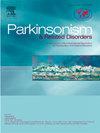The effect of subjective postural vertical on forward flexed posture in Parkinson's disease
IF 3.4
3区 医学
Q2 CLINICAL NEUROLOGY
引用次数: 0
Abstract
Background
We developed a novel method to measure the angle of subjective postural vertical (SPV) and showed that the SPV may be related to the exacerbation of the forward flexed posture.
Objectives
The present study prospectively tested the effects of the subjective postural vertical on the exacerbation of the forward flexion of trunk (FFT) through long-term observation of Parkinson's disease patients.
Methods
Evaluation of the posture included measuring FFT, the angle of lateral flexion of trunk, and the angle at the position that the patient subjectively perceived as the vertical position at a stationary upright position immediately after standing up at the time of initial observation, 6 months later, and 1 year later.
Results
The SPV angles worsened significantly at 6 months and 1 year compared to the first measurements (9.3 ± 6.7° vs. 10.8 ± 8.2° and 10.6 ± 7.8°, P < 0.05), and the FFT angles worsened significantly at one year compared to the first measurements (11.1 ± 8.1° vs. 12.2 ± 8.8°, P = 0.004). Furthermore, using a hierarchical multiple regression model, the difference in SPV from the first visit to the first half year was considered a factor contributing to annual FFT change (P = 0.002).
Conclusions
This longitudinal study of a large number of cases suggested that changes in SPV may precede changes in FFT.
主观姿势垂直对帕金森病患者前屈姿势的影响。
背景:我们开发了一种测量主观姿势垂直角度(SPV)的新方法,结果表明SPV可能与前屈姿势的加重有关:我们开发了一种测量主观姿势垂直角度(SPV)的新方法,并证明SPV可能与前屈姿势的加重有关:本研究通过对帕金森病患者的长期观察,前瞻性地测试了主观姿势垂直度对躯干前屈(FFT)加重的影响:方法:姿势评估包括测量躯干前屈角度、躯干侧屈角度,以及患者在初次观察时、6个月后和1年后站立后主观认为的静止直立姿势垂直位置的角度:结果:与首次测量结果相比,6个月和1年后的SPV角度明显恶化(9.3 ± 6.7° vs. 10.8 ± 8.2° and 10.6 ± 7.8°, P 结论:这项对大量病例进行的纵向研究表明,SPV 的变化可能先于 FFT 的变化。
本文章由计算机程序翻译,如有差异,请以英文原文为准。
求助全文
约1分钟内获得全文
求助全文
来源期刊

Parkinsonism & related disorders
医学-临床神经学
CiteScore
6.20
自引率
4.90%
发文量
292
审稿时长
39 days
期刊介绍:
Parkinsonism & Related Disorders publishes the results of basic and clinical research contributing to the understanding, diagnosis and treatment of all neurodegenerative syndromes in which Parkinsonism, Essential Tremor or related movement disorders may be a feature. Regular features will include: Review Articles, Point of View articles, Full-length Articles, Short Communications, Case Reports and Letter to the Editor.
 求助内容:
求助内容: 应助结果提醒方式:
应助结果提醒方式:


